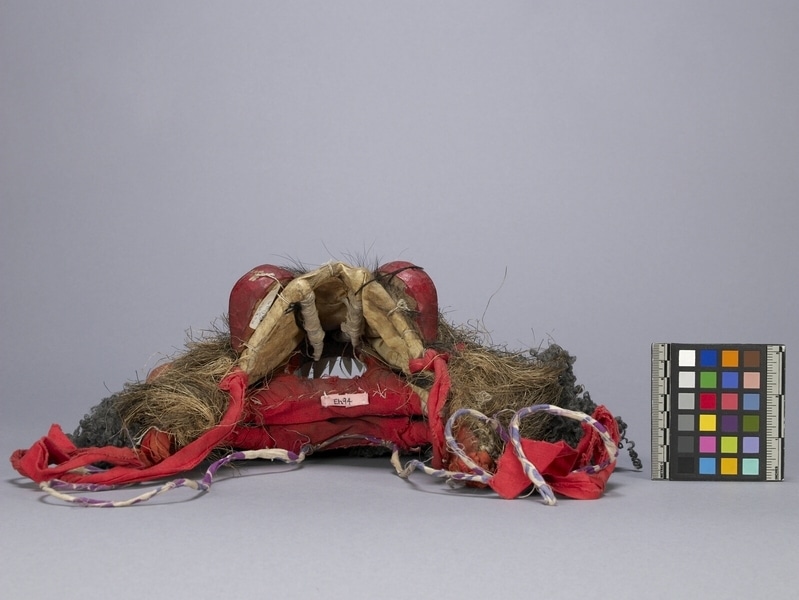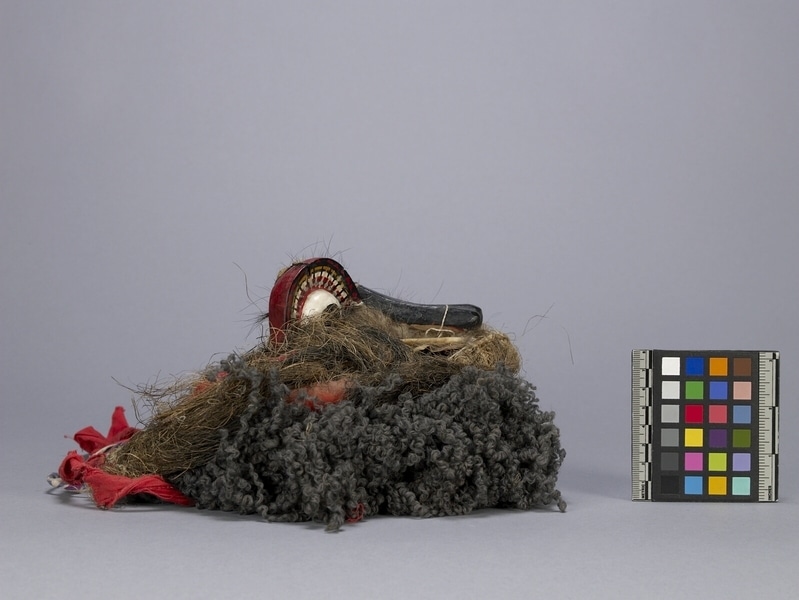Mask Item Number: Eh94 from the MOA: University of British Columbia




Description
Kukulu Paliya mask (a form of sanni mask) depicting an animal consisting of two padded wire ? frames, each composed of three wire loops, that have been wrapped in red fabric and hinged together to form a jointed, movable jaw. The upper frame supports a muzzle of light yellow-brown hide with a long, black, flaring wooden nose. The creature also has wooden bulging eyes with black pupils surmounted by eyebrows that are attached individually by string to the muzzle and are decorated with geometric patterns in red, yellow, white and black. At the top front of the muzzle is a moustache of stiff plant fibre. The upper and lower frames each have three small jaws (formed by each wire loop), each with their own set of triangular white plastic teeth. A large curly beard made of uneven strands of tightly coiled dark grey wool, tinged light brown to red in some areas, runs the full outer edge of the bottom jaw. Fabric ties are attached to the jaw. A white adhesive label behind the back of the creature's left eyebrow reads, "Kukulu Paliya."
History Of Use
Worn during curing ritual of the Sanni Yakuma ceremony, part of the Tovil series of dramas performed by Sinhalese ritual specialists and dancers. The Sanni Yakuma is intended to combat diseases and afflictions caused by the Sanni group of demons. These consist of 18 or more apparitions of the chief demon, Maha-kola-sanni. The officiating healer honours Buddha, then appeases the demons with offerings, dancing, and chanting.
Cultural Context
ceremonial
Item History
- Made in Matara, Sri Lanka before 1980
- Collected during December 1980
- Owned by Jason Schoonover before June 10, 1982
- Received from Jason Schoonover (Seller) and Museum of Anthropology Shop Volunteers (Funding source) on June 10, 1982
What
- Name
- Mask
- Identification Number
- Eh94
- Type of Item
- mask
- Material
- wool fibre, skin, plant fibre, plastic ? and paint
- Manufacturing Technique
- carved and smoked
- Overall
- height 14.0 cm, width 24.0 cm, depth 22.5 cm
Who
- Culture
- Sinhalese
- Previous Owner
- Jason Schoonover
- Received from
- Jason Schoonover (Seller) and Museum of Anthropology Shop Volunteers (Funding source)
Where
- Holding Institution
- MOA: University of British Columbia
- Made in
- Matara, Sri Lanka
When
- Creation Date
- before 1980
- Collection Date
- during December 1980
- Ownership Date
- before June 10, 1982
- Acquisition Date
- on June 10, 1982
Other
- Condition
- fair
- Accession Number
- 0812/0010